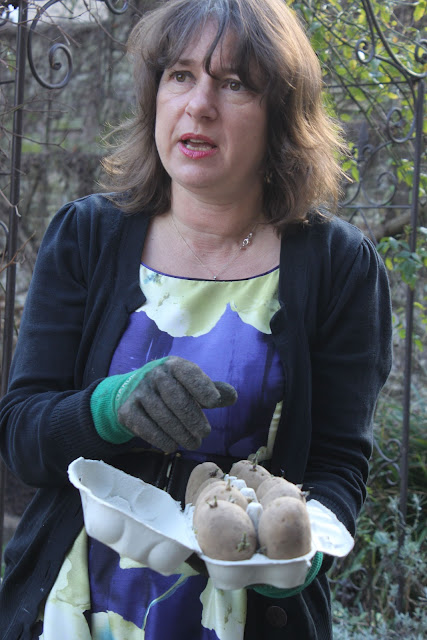 |
| Zia Mays |
The Secret Garden Club met on Sunday February 26th to discuss potatoes – including a look at heritage varieties, some tips on growing in restricted space and how to raise a successful crop out in the open ground. The afternoon began with a potato vodka cocktail garnished with potato crisps before moving out into the garden.
 |
| I’m afraid I drank it before I could take the picture! But revelation! Potato vodka is soo much smoother than grain vodka. I bought Chase, the only potato vodka available in the UK. |
There are something like 450-500 varieties grown in the UK, but only a few of these ever make it into the shops. To find some of the more unusual potatoes, you’ll need to look online for mail order suppliers, at Farmers’ Markets … or grow them yourself.
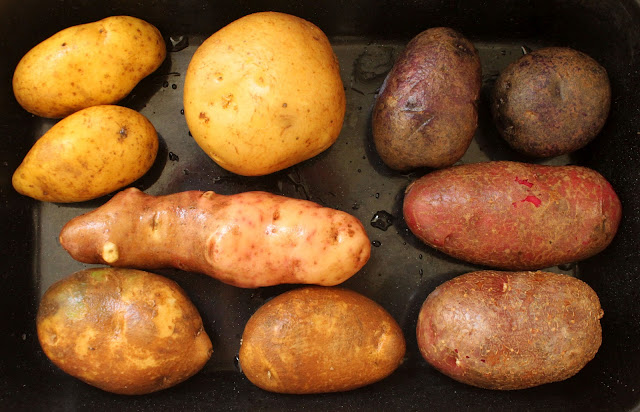 |
| Clockwise from top right: Golden wonder, Orla, Salad Blue, Highland Burgundy, Mayan Gold, Pink Fir apple (centre left). |
On Sunday, we looked at some heritage varieties all grown in the UK, but generally only available to grow or from specialist suppliers such as Carrolls.
- Highland Burgundy – a close relative of ancient South American potatoes, but this particular strain was probably cultivated around 80 years ago.
- Mayan Gold – these have been bred specifically in Scotland from an ancient Peruvian potato, Solanum phureja.
- Salad Blue – the deep blue colour comes from anthocyanins in the flesh. Bred by the Victorians in Scotland
- Golden Wonder – a very floury maincrop potato. Great for baking and chips … and used to make potato crisps!
- Pink Fir Apple – originally imported into Britain in 1850 and bred for its fine flavour. Unusually, it’s a maincrop potato which boils well and is great for salads.
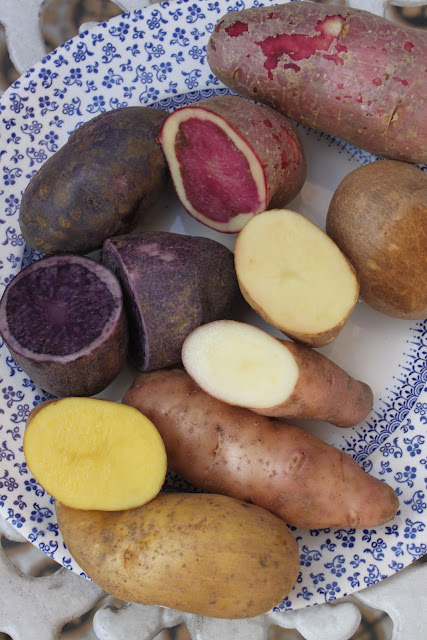 |
| Here they are cut up: amazing colours! |
Potato jargon
Terms like waxy and floury refer to the texture of the potato. Waxy potatoes have the texture you associate with new potatoes and potatoes in salad. Floury is that fluffiness you get inside baking and roasted potatoes when cooked.
These textures are determined by the water content of the potato. A high water content makes for a waxy spud. High dry matter makes the potato floury, and floury potatoes are generally not good for boiling: they will break down in the pan.
A common complaint of potato growers is that the potatoes break down in the pan when they boil them, even if they are Charlottes, or another salad type. The likelihood is that the growing conditions were just too dry – they didn’t get watered often enough.
The terms 1st Early, 2nd Early and Maincrop are often used to describe seed potatoes and simply refer to the amount of time take to mature.
- First early potatoes produce usable tubers in 100-110 days after planting;
- Second earlies in 110-120 days;
- Early maincrops after 120-125 days;
- Maincrops produce tubers after 125-140 days.
So, for example, you can plant early potatoes in late summer in order to have freshly dug new potatoes on Christmas Day. They are still early potatoes, regardless of the type of year they are planted.
There’s no doubt that growing potatoes in the open ground, whether a garden bed or an allotment, takes up a lot of space. And a lot of space is usually something the urban gardener doesn’t have.
However, you don’t have to grow them in the open ground at all. You can grow potatoes in a container. Because of the way in which potatoes are looked after while they’re growing, the best type of container to use is a strong sack … or indeed, a bin liner.
You might have seen advertisements in the Sunday magazines for special potato sacks, but you don’t need them. A nice strong black binbag will do. Or a compost bag, so long as it has that black lining inside. The black lining is to keep the light out, so that the potatoes inside don’t go green.
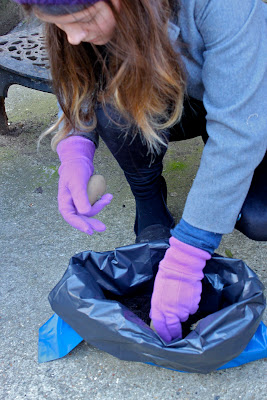 |
| Growing in a container |
The potatoes we planted in the compost bags on Sunday are a variety called Lady Christl and they are my favourite new potato. They are always ready nice and early, they have beautiful, unblemished yellow skins and creamy white flesh. The potato is firm with a delicate nutty flavour and they make a delicious salad.
When we planted them, the Lady Christl potatoes had little shoots emerging. This means the potatoes have been chitted, ie, stored in a light cool place so that the shoots develop. Note, a light cool place. If you want to store potatoes for eating, keep them in the dark. If you want to store them before planting, keep them in the light.
It’s not essential to chit potatoes but it does get them off to a head start in the ground. It also helps you when you’re planting them out as you can see where the shoots will develop and plant them the right way up.
Each compost bag will take three seed potatoes, seed potatoes being the starter which will grow into new potato plants. From each seed potato you should be able to harvest around eight or nine eating potatoes.
It’s not just the space-saving aspect: there are lots of advantages to growing potatoes in a container:
- Less hard work – no digging;
- Portability 1 – if you get a bad weather warning (eg, frost) when the plants are young and tender, you can move them indoors/under cover;
- Portability 2 – you can place the bags more or less wherever you like.
- Less risk of disease – your purpose-bought compost shouldn’t be harbouring blight spores, eelworms or any other nasties;
- You don’t need to dig out the potatoes with a fork or spade, so there is little or no chance of damaging the spuds when harvesting;
- Gardeners often miss very small potatoes and leave them in the ground over winter. By growing them in a bag you can ensure you harvest your entire crop.
1) The first thing to do is to put about three inches of compost in the bottom of the bag, spread evenly. Make it easier for yourself by rolling the sides of the bag down so that your bag is about six inches tall. You’ll want the sides rolled down anyway after you plant the potatoes – if you keep the bags at full height your potatoes will never see the sun and they won’t grow.
2) Next you want to take a sharpened pencil or sharp stick and make some drainage holes in the bottom of your potato bag. This is very important – you do not want waterlogged potatoes. They will rot, and they will stink while they’re doing it.
So, make about 5-6 drainage holes at the foot of each bag.
3) Now place three potatoes into the bag. Space them out evenly.
Always use seed potatoes, ie, bought from a nursery or garden centre specifically for growing. Seed potatoes should be guaranteed free from viruses, which culinary potatoes won’t be. Potatoes in the shops may have been sprayed with a shoot suppressant.
Potatoes in the shops may not have been grown in the UK and so may not be well adapted to grow here. Many, if not most, of the seed potatoes grown in the UK come from Scotland and are bred to grow well in our conditions.
4) The potatoes should go into the sack with the chits uppermost.
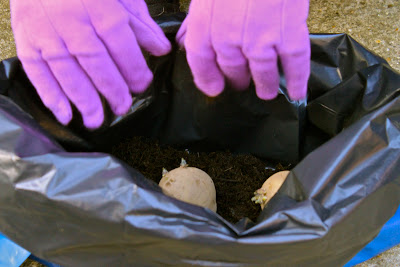 |
| Yup, see them little roots… they go upwards, those will be the shoots growing above the ground to grab some sunlight for the plant. |
You can grow potatoes without chitting them first but they take longer to get going. You can also cut seed potatoes up into divisions each with its own little chit and plant them individually, but you do get bigger plants and more potatoes by planting the whole spud, chits and all.
5) Once the potatoes are in, cover them with more compost: aim to have a layer of compost about 2-3 inches thick over the chits.
6) Finally, water them lightly. They don’t need to be soaked. Check that water is seeping out of the drainage holes.
7) Put the potato bag outside somewhere light and somewhere reasonably sheltered.
You’ll need to bring the bag inside if a frost is forecast. It’s not unusual to get frost in March in London; much more unusual in April, although we’ve had late frosts in each of the last two years.
8) After about 2-3 weeks you’ll see the dark green leaves poking up through the soil surface. Once the leaves are about 3-4 inches above the surface of the compost, add more compost to the bag, until the green tops are only just visible above the soil surface.
You’ll probably need to starting unroll the sides to accommodate the new compost as well. This is an ongoing process. Every time the plant grows so that you have about 3-4 inches of stem and leaves above the surface, unroll the sides a little more and add more compost.
If it rains a couple of times a week, you probably won’t need to water them. But do check your compost: if it’s very dry, then water it. Make sure any excess water is running out through those drainage holes. If it rains a lot and you put your hand in and the compost is sodden, move the bag under cover for a few days to let it dry out a bit.
These are early potatoes, so will take about 100-110 days to reach maturity.
So, in about mid-June, you can put on a pair of gloves and stick your hand into the compost. If the lumps are still tiny, leave them longer. If you can feel that you have big potatoes, start harvesting.
Other signs are also useful: once the potato plant is flowering you can try digging up some spuds, or your deep green foliage might start turning yellowy and begin to wilt.
The best way to harvest here is simply to up-end the bag on to a surface and pick out the potatoes. Put the rest of the plant on the compost heap and spread the compost on your garden beds.
You can store your potatoes for quite some time. Don’t put them in the fridge (that will turn the starch in the potatoes to sugar), but do put them somewhere cool, dry and dark. If you keep them out on a rack they will go green, and they will start to sprout. Neither of these is any good for eating.
Growing in the open ground
However, there are good reasons why you might want to grow potatoes in the open ground, if you’re lucky enough to have the space.
- You will get higher yields, ie, more potatoes, from a plant grown in a proper bed.
- They need less looking after – no fiddling around with bags.
- A potato bed is more attractive than having plastic compost sacks around the place.
There is also a well-known maxim among gardeners that potatoes help to break up your soil. They’re a popular choice for growing in new territory for that reason. I have my own thoughts on this. I don’t think it’s the potatoes that break up the soil at all. I think it’s you, the gardener. Growing potatoes here in the open ground involves hard manual labour.
- You have to dig a trench. You add organic matter, or fertiliser, maybe.
- You earth up several times.
- You dig deep again to harvest the potatoes.
So, yes, potatoes are a great crop for breaking up the soil. But it won’t happen by magic. It will be your hard effort that does the work.
One extra benefit of growing potatoes in new ground, though, is that they have big leaves and plenty of them, which makes for a good natural weed suppressant. Weeds tend not to grow underneath.
The first step is to dig a trench. Anywhere from 3 to 8 inches deep, say about five inches is best.
You might like to add some potato fertiliser to the bottom of the trench. It may well help to increase the yield. Fertiliser formulated for potatoes will be high in nitrogen, so any nitrogen-rich fertiliser will do fine. Incidentally, potatoes like slightly acid soil. If you’re gardening in London and you have heavy clay soil, you should be fine, as clay tends to be slightly acid itself.
The potatoes we planted on Sunday were Pink Fir Apples. This is a maincrop potato, and normally you would plant maincrops in April, and start harvesting in August or September. Planted this early, they will need some protection against cold.
Lay your potatoes, chits uppermost at the bottom of the trench. The potatoes should be 12-18 inches apart and the rows should be spaced 2ft apart. Water lightly.
Cover carefully with soil. Ideally you want to finish off with a little ridge where the plant will emerge – your first piece of earthing up (it also helps you to remember where the plant is as it takes about 3-4 weeks for the shoots to appear above ground).
Once the plant has two sets of leaves, start earthing up. Earthing up involves drawing, with a hoe, soil from the area between the rows to cover most of the stem of the growing plant. Earthing up encourages the plant to produce more tubers and keeps them in the dark. The developing potatoes will turn green if exposed to the light, and the green bits are poisonous. To get a good crop of healthy potatoes, keep them dark and undercover.
In practice, earthing up isn’t essential if you have other ways of keeping potatoes under cover. Mulching the crop with grass cuttings is one way to keep the potatoes that developing dark and it’s much less strenuous than earthing up. This is also practical because the potato plants are growing as the same as your lawn starts growing, so you will have a weekly supply of grass cuttings just when you need them.
Potato problems
Potatoes grown in open ground are also more susceptible to diseases and disorders.
- Blight
- Eelworms
- Wireworms, slugs
- Frost damage
Blight
Blight is probably the most common problem. It’s a fungus-like organism, which first shows up as brown patches on leaves and blackening of the stems. If you catch it very early and remove and burn the affected material you may be able to stop it from spreading down to the tubers underground.
Blight is prevalent in summer, from about July onwards, and will spread when it’s cloudy and humid – as it often is in July. If you grow potatoes in a garden and there aren’t many other potato growers nearby you may escape blight altogether – although beware as it’s the same organism that attacks tomatoes, so you also need to have no tomato growers in the vicinity. On an allotment it can spread like wildfire.
But there are preventative measures. Early potatoes should be ready by the end of June so should avoid blight altogether. Constant checking and removal of any blotched leaves will help check the spread.
There are also blight-resistant varieties of potatoes, notably Sarpo. Sarpo Mira is well thought of – again, not a variety you’ll find in the shops but a good one to grow.
Potato eelworm
You might also get potato eelworm cysts. You dig up the crop and instead of potatoes you have tiny white or yellow cysts on the underground stems. There’s no chemical treatment available: practise good crop rotation. Eelworms don’t move much so just because they’re in one bed doesn’t necessarily mean they’ll be in the next-door bed. Again, grow only earlies. They’ll be ready to harvest before the eelworm reaches the harmful phase of its life cycle. There are some resistant varieties: try Sante.
Wireworms and slugs
Wireworms will drill thin holes in your potatoes. They are thought to be a problem mainly when you grow on new ground, so constant cultivation should reduce wireworm attacks.
Slugs are more likely to be a problem if you leave the potatoes in the ground only digging them up when you need them. Try lifting and storing the crop all at once.
If slugs are a big problem, apply a nematode solution on the patch before you plant the potatoes.
Frost damage
Another potential problem which should be taken into account is frost damage – potato plants are vulnerable to frost and so can be affected by a late frost. There was one very late frost in London in May in 2010 – wiped out my early potatoes, and this year, I lost 2-3 plants to a mild frost in April.
That April the maincrop potatoes were still underground and hadn’t yet sprouted. They were fine. It was only the earlies which were affected.
Having said all this about hard work and diseases and problems, I’ve made growing potatoes sound like very hard work, and it’s true that they do require a certain amount of physical effort to grow outdoors.
But of all the problems I’ve outlined above, late frost is the only one I’ve ever personally suffered from.
And of course if you grow in a container, these problems shouldn’t arise at all.






Leave a Reply